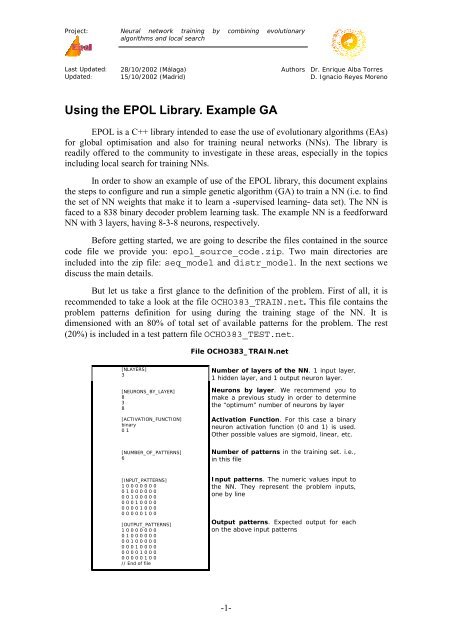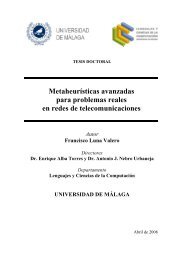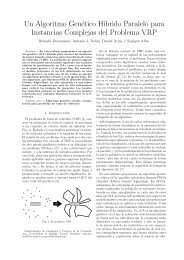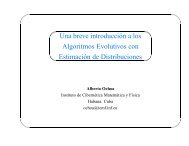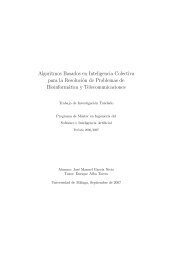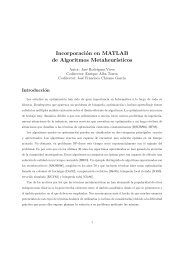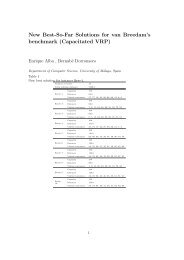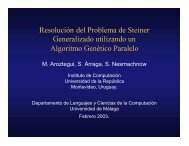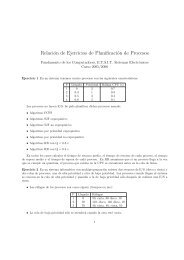Using the EPOL Library. Example GA - NEO
Using the EPOL Library. Example GA - NEO
Using the EPOL Library. Example GA - NEO
Create successful ePaper yourself
Turn your PDF publications into a flip-book with our unique Google optimized e-Paper software.
Project:<br />
Neural network training by combining evolutionary<br />
algorithms and local search<br />
Last Updated: 28/10/2002 (Málaga) Authors Dr. Enrique Alba Torres<br />
Updated: 15/10/2002 (Madrid) D. Ignacio Reyes Moreno<br />
<strong>Using</strong> <strong>the</strong> <strong>EPOL</strong> <strong>Library</strong>. <strong>Example</strong> <strong>GA</strong><br />
<strong>EPOL</strong> is a C++ library intended to ease <strong>the</strong> use of evolutionary algorithms (EAs)<br />
for global optimisation and also for training neural networks (NNs). The library is<br />
readily offered to <strong>the</strong> community to investigate in <strong>the</strong>se areas, especially in <strong>the</strong> topics<br />
including local search for training NNs.<br />
In order to show an example of use of <strong>the</strong> <strong>EPOL</strong> library, this document explains<br />
<strong>the</strong> steps to configure and run a simple genetic algorithm (<strong>GA</strong>) to train a NN (i.e. to find<br />
<strong>the</strong> set of NN weights that make it to learn a -supervised learning- data set). The NN is<br />
faced to a 838 binary decoder problem learning task. The example NN is a feedforward<br />
NN with 3 layers, having 8-3-8 neurons, respectively.<br />
Before getting started, we are going to describe <strong>the</strong> files contained in <strong>the</strong> source<br />
code file we provide you: epol_source_code.zip. Two main directories are<br />
included into <strong>the</strong> zip file: seq_model and distr_model. In <strong>the</strong> next sections we<br />
discuss <strong>the</strong> main details.<br />
But let us take a first glance to <strong>the</strong> definition of <strong>the</strong> problem. First of all, it is<br />
recommended to take a look at <strong>the</strong> file OCHO383_TRAIN.net. This file contains <strong>the</strong><br />
problem patterns definition for using during <strong>the</strong> training stage of <strong>the</strong> NN. It is<br />
dimensioned with an 80% of total set of available patterns for <strong>the</strong> problem. The rest<br />
(20%) is included in a test pattern file OCHO383_TEST.net.<br />
[NLAYERS]<br />
3<br />
[NEURONS_BY_LAYER]<br />
8<br />
3<br />
8<br />
[ACTIVATION_FUNCTION]<br />
binary<br />
0 1<br />
[NUMBER_OF_PATTERNS]<br />
6<br />
[INPUT_PATTERNS]<br />
1 0 0 0 0 0 0 0<br />
0 1 0 0 0 0 0 0<br />
0 0 1 0 0 0 0 0<br />
0 0 0 1 0 0 0 0<br />
0 0 0 0 1 0 0 0<br />
0 0 0 0 0 1 0 0<br />
[OUTPUT_PATTERNS]<br />
1 0 0 0 0 0 0 0<br />
0 1 0 0 0 0 0 0<br />
0 0 1 0 0 0 0 0<br />
0 0 0 1 0 0 0 0<br />
0 0 0 0 1 0 0 0<br />
0 0 0 0 0 1 0 0<br />
// End of file<br />
File OCHO383_TRAIN.net<br />
Number of layers of <strong>the</strong> NN. 1 input layer,<br />
1 hidden layer, and 1 output neuron layer.<br />
Neurons by layer. We recommend you to<br />
make a previous study in order to determine<br />
<strong>the</strong> “optimum” number of neurons by layer<br />
Activation Function. For this case a binary<br />
neuron activation function (0 and 1) is used.<br />
O<strong>the</strong>r possible values are sigmoid, linear, etc.<br />
Number of patterns in <strong>the</strong> training set. i.e.,<br />
in this file<br />
Input patterns. The numeric values input to<br />
<strong>the</strong> NN. They represent <strong>the</strong> problem inputs,<br />
one by line<br />
Output patterns. Expected output for each<br />
on <strong>the</strong> above input patterns<br />
-1-
Project:<br />
Neural network training by combining evolutionary<br />
algorithms and local search<br />
Last Updated: 28/10/2002 (Málaga) Authors Dr. Enrique Alba Torres<br />
Updated: 15/10/2002 (Madrid) D. Ignacio Reyes Moreno<br />
In a similar way, we can format <strong>the</strong> test pattern file. For this case however, you<br />
should avoid any specification for <strong>the</strong> sections ACTIVATION_FUNCTION and<br />
NEURONS_BY_LAYER, because this information was recorded by NN C++ class<br />
object when loading <strong>the</strong> train pattern set just described.<br />
File OCHO383_TEST.NET<br />
[NUMBER_OF_PATTERNS]<br />
2<br />
[INPUT_PATTERNS]<br />
0 0 0 0 0 0 1 0<br />
0 0 0 0 0 0 0 1<br />
[OUTPUT_PATTERNS]<br />
0 0 0 0 0 0 1 0<br />
0 0 0 0 0 0 0 1<br />
// End of file<br />
Notice that in this typical test file <strong>the</strong> number of required sections are reduced to<br />
three, since <strong>the</strong> rest if information has been defined for <strong>the</strong> training process.<br />
Therefore, we have just described <strong>the</strong> architecture of <strong>the</strong> NN and <strong>the</strong> data sets<br />
used to train and to test <strong>the</strong> results of <strong>the</strong> constructed NNs. But, in order to construct<br />
(train and test) <strong>the</strong> best possible NN we need a learning algorithm. There exist many<br />
alternative techniques for this task, such as backpropagation of <strong>the</strong> errors, but heuristic<br />
techniques are continuously being proposed with success.<br />
Next, we discuss a brief description of both sequential and distributed models in<br />
<strong>the</strong> following sections.<br />
Authors’ note: This document should be read in conjunction with <strong>the</strong> stuff included in <strong>the</strong> <strong>EPOL</strong><br />
CONFIGURATION SECTION from our Web Site.<br />
-2-
Project:<br />
Neural network training by combining evolutionary<br />
algorithms and local search<br />
Last Updated: 28/10/2002 (Málaga) Authors Dr. Enrique Alba Torres<br />
Updated: 15/10/2002 (Madrid) D. Ignacio Reyes Moreno<br />
Sequential Model<br />
The seq_model directory contains <strong>the</strong> source code and configuration files to<br />
run <strong>the</strong> NN training problem using <strong>EPOL</strong> in sequential. Before running this example, let<br />
us have a look to <strong>the</strong> required files:<br />
• xxx.param file. This file contains all <strong>the</strong> parameters needed to<br />
configurate <strong>EPOL</strong>. This file contains some sections, <strong>the</strong> most important<br />
ones are: NUMBER_OF_OPERATOR, SEED (initialize <strong>the</strong> random<br />
seed used by <strong>the</strong> <strong>GA</strong> in its randomized operations), OPERATORS,<br />
PROBLEM_CONFIG_FILE, NUMERIC_RANGES, and<br />
OUTPUT_DISPLAY. For this example we will use <strong>the</strong> file<br />
seq_decoder_ga.param<br />
• xxx.net files. As we mention above, for each NN problem to be<br />
solved in <strong>EPOL</strong> we will need 2 .net files, namely one for training and<br />
one for testing <strong>the</strong> pattern set. Our training and evaluation pattern sets for<br />
<strong>the</strong> encoded example are, respectively: OCHO383_train.net and<br />
OCHO383_test.net.<br />
• xxx.out file. This file is created every time <strong>the</strong> OUTPUT_DISPLAY<br />
section from <strong>the</strong> .param file is set to ALL. The file contains <strong>the</strong> results<br />
of a trace of execution. It’s recommended to set this param when<br />
debugging <strong>the</strong> behaviour of <strong>the</strong> EA.<br />
Now that we have presented <strong>the</strong> main files for this example, we need to<br />
implement <strong>the</strong> <strong>GA</strong> algorithm in a .cpp file using <strong>the</strong> classes and services of <strong>EPOL</strong>. To<br />
reach this goal for <strong>the</strong> NN training problem just open <strong>the</strong> file<br />
main_decoder_ga.cpp file to see how it implementes <strong>the</strong> example at hands (a<br />
simple <strong>GA</strong> that trains a NN for <strong>the</strong> encoder problem). Follow <strong>the</strong> instructions made in<br />
<strong>the</strong> comments.<br />
Once you understand completely all <strong>the</strong> files mentioned before, it’s time to<br />
compile and generate an executable file. For sequential projects, use <strong>the</strong> makefile in<br />
<strong>the</strong> directory seq_model. Write at <strong>the</strong> prompt of your system: “makefile –f<br />
ga_example”. You should have installed a g++ compiler with version greater than<br />
2.0, because we are using templates that might cause some problems in earlier versions.<br />
Now <strong>the</strong> system is ready. Just execute <strong>the</strong> file ga_decoder.exe and wait<br />
until <strong>EPOL</strong> ends. A report will be issued to your console and a result file will be<br />
generated.<br />
Authors’ note: <strong>EPOL</strong> has been designed to be executed under Linux or Unix machines with g++<br />
compiler. At this moment, we do not know of any incompatibility or bug for it.<br />
Anyway, if you detect any problem with <strong>EPOL</strong>, please, do not hesitate to write us with<br />
<strong>the</strong> error description you got. We will provide a solution to it in our Web page as soon<br />
as possible.<br />
-3-
Project:<br />
Neural network training by combining evolutionary<br />
algorithms and local search<br />
Last Updated: 28/10/2002 (Málaga) Authors Dr. Enrique Alba Torres<br />
Updated: 15/10/2002 (Madrid) D. Ignacio Reyes Moreno<br />
Distributed Model<br />
A distributed model is an extension of <strong>the</strong> basic centralized model. You may<br />
want to analyze a distributed model to solve problems with your sequential or<br />
centralized algorithm such as premature convergence to local optima, high<br />
computational times, or just to investigate new models of optimisation.<br />
The main differences between <strong>the</strong> sequential and <strong>the</strong> distributed EA models ca<br />
be found in <strong>the</strong> way by which <strong>the</strong> evolutionary algorithm evolves. In <strong>the</strong> following, we<br />
are going to learn how to configured a distributed island model (<strong>the</strong> one <strong>EPOL</strong> uses). It<br />
is assumed that <strong>the</strong> population of <strong>the</strong> sequential model is distributed in several subpopulations<br />
that undergo separate evolution to search a solution for <strong>the</strong> same problem.<br />
These sub-algorithms sparsely exchange information to collaborate in this task in a ring<br />
of processes.<br />
Here, we only discuss <strong>the</strong> differences (<strong>the</strong> additionally needed files) with respect<br />
<strong>the</strong> sequential versions. The first additional file we must take care of is <strong>the</strong> island<br />
implementation file. This file is named island_decoder.cpp; it contains <strong>the</strong><br />
definition and implementation of a real coded EA. The island configuration file is<br />
island.par. For simplicity, we asume that <strong>the</strong> islands share <strong>the</strong> same configuration<br />
file, but this is just a simplification. End users may want to use different ones to conduct<br />
an heterogeneous search.<br />
Yet ano<strong>the</strong>r important file to mention is <strong>the</strong> monitor_decoder.cpp file.<br />
This file contains <strong>the</strong> definition and implementation of a distributed ring of processes<br />
with a monitor process that internally manage <strong>the</strong> parallel computations. Our monitor<br />
reads <strong>the</strong> monitor.par file which contains <strong>the</strong> necessary information to execute it<br />
properly.<br />
Basically, <strong>the</strong>se are <strong>the</strong> most important files we need. Now, in order to execute<br />
<strong>the</strong> distributed model, we need to compile. For this purpose, type makefile –f<br />
all. This sentence creates <strong>the</strong> executable files. Now execute monitor.exe and wait<br />
for <strong>the</strong> results.<br />
Authors’ note: Read carefully <strong>the</strong> files monitor_decoder.cpp and island_decoder.cpp to know which<br />
arguments must be passed to <strong>the</strong>se two programs.<br />
-4-


